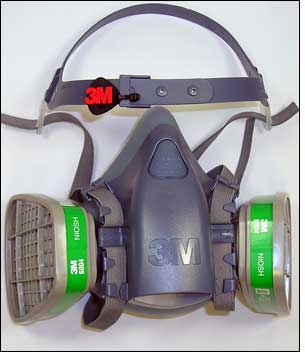Industrial hygiene service provider Colden Corp. is saving several hours of labor per week, as well as gaining a greater amount of inspection and maintenance data, by scanning RFID tags on the 3M respirators it services. The system helps the company track when its employees inspect respirators at a northwestern Pennsylvania locomotive manufacturer (that asked to be unnamed). The three inspectors who utilize the system carry handheld interrogators that they use to read the ID number on each respirator they inspect. The data is then stored on a Web-based system hosted by 3M, which manufactures the respirators, as well the RFID system itself.
Until spring 2009, Colden managed all of its inspection sites manually. The company provides weekly inspection and maintenance services on safety equipment for a variety of firms—frequently manufacturers. OSHA requires that such respirators be cleaned, maintained and tested. To track the service provided, for its own records as well as for the manufacturer, Colden’s inspectors used pen and paper to manually record the ID number of each piece of equipment, as well as its condition and the service provided.
At the end of the day, the inspectors brought the paperwork back to the office. There, an employee entered all of the data into the computer, where it was stored on an Excel spreadsheet and prepared for the customer. The process was not only time-consuming, says Christopher Wesley, a principal at Colden, but it could also be error-prone, since employees could record the numbers or other details incorrectly, including which individual was using which piece of equipment.
Colden is now trialing an RFID system, however, that is resolving these problems, Wesley says. 3M has been using RFID tags for tracking items such as files in offices for approximately a decade, according to Larry Ptastenski, the new business development manager of 3M’s Occupational Health & Environmental Safety division. When its customers began complaining of their difficulties tracking inspections, 3M started looking for an RFID-based solution.
“Industrial hygienists have been having trouble measuring whether the safety plans they have in place are working properly,” Ptastenski explains. “So that’s how we got started. One of our strengths is leveraging technology across our organization.” Since 3M had already been providing RFID solutions to some of its other customers, he says, the movement into tagging respirators was an easy adjustment. The company tested RFID tags on respirators in 2008, to track their movement into and out of a tool crib at a manufacturing company in Australia, and this year began making the solution available to Colden, its first U.S. customer for that system.Colden used plastic ties to attach 13.56 MHz RFID tags, complying with the ISO 15693 standard, to 400 employee lockers and 400 3M respirators within those lockers, which Colden provides to the Pennsylvania manufacturer. Each tag is encoded with a unique ID number, and that tag number is linked in a database to the respirator’s serial number, the type of respirator it is (indicating the type of maintenance required) and the name of the person to whom that respirator is assigned. The tag ID number is also linked to the locker tag’s unique ID number, which is associated with data regarding the building number, the location within the building and the user of the locker and respirator. All of this information resides in a Web-based server hosted by 3M. Colden pays a monthly fee to access that data and create regular reports for its customers.
When the three inspectors arrive each week at the manufacturing site, they are armed with iPAQ pocket PCs with socket RFID readers provided by 3M. The handhelds can transmit data via a Wi-Fi connection—but in the case of Colden’s client, there is no Wi-Fi connection, so inspectors store data on the device, then download it later at the Colden office.
With each scan of a respirator and locker tag, the inspector can view details on the device’s screen regarding that respirator and its maintenance history. While conducting the inspection and any maintenance, he or she inputs those actions in the pocket PC, thereby creating a record not only of the action taken, but also of the time and date at which it occurred. If the respirator is missing, the inspector scans the locker ID number and indicates that item was not found or inspected.
At the end of the day, the data is downloaded into the 3M system. Colden can then access that information in order to prepare a report to provide to the manufacturer. The company can also receive alerts from the system indicating which respirators need to be maintained, or have parts replaced, within a specific amount of time.
Initially, Wesley says, the system was trialed concurrently with the manual system, to ensure it was operating properly. Today, the inspectors utilize the RFID interrogators exclusively, and have stopped generating paper inspection records. Inspectors found the system easy to use, he says, and required little training.“I think one really nice ancillary benefit is knowing what time the maintenance was conducted,” Wesley states, noting that the greatest benefit for Colden is the reduction in man-hours used by inspectors. “It saves us two to three hours a week,” he adds, “which is significant.”
According to Wesley, Colden purchased the three handheld readers and RFID tags for the respirators, and is paying the service fee, though he declines to reveal the cost involved.
“The key is that RFID allows the customer to know when something is happening,” Ptastenski says. The information stored on 3M’s cloud-computing [Internet-based] architecture, he indicates, can be customized for the needs of a specific client. Some of 3M’s respirator customers are maintenance service providers such as Colden, he notes, while others are the manufacturing sites that use the respirators themselves.
In each case, Ptastenski says, the needs for data related to inspections differ slightly. The system enables the customers to create user-defined fields—such as alerting them in advance when, for instance, an air filter cartridge needs to be changed.
Although Colden is using handheld interrogators, Ptastenski says, 3M also provides fixed pad readers that can be installed at, for example, tool cribs—such as those used by the Australian manufacturer that began testing the RFID solution in 2008. The tags and readers are provided with the data service as a retrofit kit, he adds, so that tags can be added to existing respirators. “We’re excited about this system,” he states. “We think this is helping our customers do their work better.” Eventually, he says, 3M would also like to provide the service for other safety tools, such as hard hats and safety glasses.
Colden will provide the RFID-enabled respirator system to some of its other customers in the future as well, Wesley says, though he does not indicate how soon.




